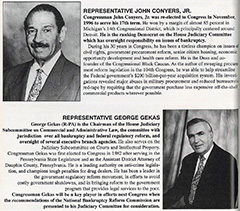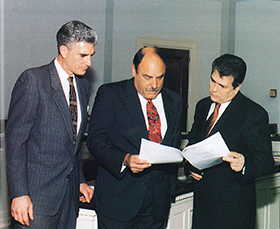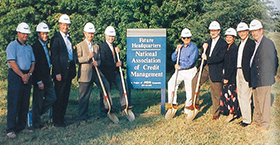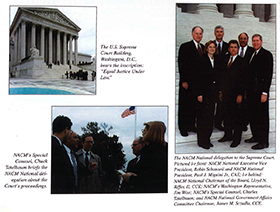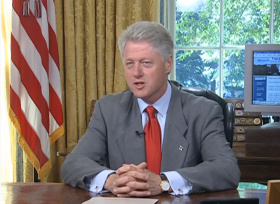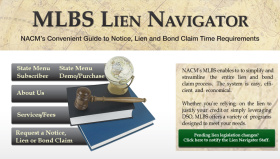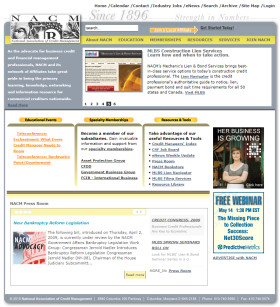1990s
The Information Age startsThe Blizzard of 1996 paralyzed the east coast with up to 4 feet of snow. It was followed by unusually warm weather and torrential rain, which caused rapid melting and river flooding.
The "Millennium Bug" caused widespread concern due to computer programs storing years with only two decimal digits. The year 2000 would thus be interpreted as 1900.
... Charles Tatelbaum, along with members of the Government Affairs Committee testify before the House Judiciary Committee on bankruptcy issues.
... in Washington D. C. where members get involved on the Hill and discuss credit and finance issues with Congressional Representatives like Representative John Conyers, Jr. and Representative George Gekas.
NACM's contacts within congress come from all political backgrounds (click to enlarge).
The Credit Research Foundation's "Future of Credit" project and the results of the study "Leading the Journey from Isolation to Integration: The Future of Business Credit" will be unveiled at the 101st Credit Congress.
... began work to introduce legislation that would amend the Miller Act, which encompasses most contracting and subcontracting laws, particularly in the area of government construction projects. There were numerous reported problems with the implementation of the Miller Act, especially with bonding requirements and payments to subcontractors.
... prepared testimony and advised the National Bankruptcy Review Commission during its critical review of bankruptcy law. And they have joined forces with the National Improved Construction Practices Committee to review construction related law.
NACM's president, Paul J. Mignini Jr (right), NACM's Corporate Counsel Charles Tatelbaum (center), and NACM's Washington Representative Jim Wise (left) review testimony. (click to enlarge).
NACM Canada was formed in response to the requests of Canadian credit professionals, demanding executive level education in the areas of business credit, finance and law.
... sent employees to the first year of the 1998-1999 Graduate School of Credit and Financial Management.
... to the United States Supreme Court in the case of Bank of America vs 203 North Lasalle Street Partnership. This was a first for NACM. The ruling dealt with the new value exception to the absolute priority rule in Chapter 11 bankruptcy proceedings. While the ruling did not establish the standards for the new value exception it did prepare a road map as to when the exception may be used.
A few photos from the delegation NACM sent (click to enlarge).
It took many decades for the Euro to become a reality. First proposed at the League of Nations in the 1920s, enthusiasm for the Euro waxed and waned over the years. It was revisited at various points in the 1940s, the 1960s, the 1970s, and 1980s. The Delors Report, proposed in 1989 by a committee of the European Commission, laid out a clear plan with established milestones which was finally accepted.
The Euro eventually became the second-largest and second-most traded currency in the foreign exchange market after the United States dollar (click to enlarge).
... revised and reworked and made available at Credit Congress.
... implemented a Y2K-compliant database system to upgrade from the system installed 10 years prior.
... two senior legal officers representing the Board of Governors of the Federal Reserve Board to clarify issues surrounding the Equal Credit Opportunity Act (ECOA) and guaranties of spouses dealing with the extension of business credit. The specific issue discussed at the meeting involved Section 202.7 of the ECOA.
FCIB launched its international business professional's designation, the CICE (Certified International Credit Executive), it was the first truly global recognition of senior professionals involved in international credit, finance, and related trade services.
2000s
The New MillenniumThe Twin Towers burning. The War on Terror was launched in response to the September 11, 2001 terrorist attack. With the goal of eliminating international terrorism, there are still operations being conducted decades later.
The decade ends in the U.S. with the Great Recession, the most significant economic downturn since the Great Depression. This had a knock-on effect against the global economy.
... its 75th birthday. CFDD had grown to be the largest NACM division with 2000 members.
... held its first Annual Credit Conference.
NACM had identified many issues that were unfair to the unsecured trade credit grantor and many of these issues were addressed in the commercial provisions in the Bankruptcy Reform Act, H. R. 833 and the bankruptcy bill S.625.
... signed into law The Electronic Signatures in Global and National Commerce Act (The E-Sign Act), making the e-signature as valid as the ink-and-paper signature. The credit professional could engage in e-credit transactions across state lines and the contract would be valid in all states.
President Clinton during his Internet Address, July 2000 (click to enlarge).
... the headquarters of FCIB and NACM. NACM and FCIB hosted a meeting with representatives from The People's Bank of China (China's Central Bank) and the four major banks in China; The Bank of China, The Agricultural Bank of China, The China Construction Bank, and The Industrial and Commercial Bank of China. The delegation visited with the hopes of expanding their knowledge about collection and management of credit information.
NACM Chairman of the Board Jack Clark, CCE and NACM President Paul J. Mignini, Jr., CAE were invited to a reception at the home of Congresswoman Ellen Tauscher (D-CA) to meet with President Clinton and discuss issues of importance to the association. In particular Jack and Paul discussed the need for a bankruptcy reform bill before the end of the year, clarification of proposed changes to the Equal Credit Opportunity Act, and a greater understanding of the nature of trade credit in an "e-commerce" environment.
... on its website: one for Affiliates and one for members of the local and the National Boards.
... to automate the collections process, specifically designed for the credit and collection industry. This automation of clerical tasks left more time for the collector to make contacts and perform tasks that couldn't be automated.
... brought Affiliated Association Presidents, members of the National Board, and National Staff together to discuss mutual needs and developed a plan to implement strategic goals for the future of NACM.
... impacts business credit. The GLB was intended to apply to all business entities with respect to privacy provisions. With the ambiguous nature of the legislation after many concerns and further research it was found that it did not apply to trade or business credit.
NACM celebrates the most sweeping overhaul of Bankruptcy Legislation in 20 years, the Senate approved S. 420, the Bankruptcy Reform Act of 2001, by a vote of 83-15. The House had already approved its version of the bill. NACM worked very hard to ensure that provisions important the trade credit industry were included in both versions of the legislation.
The first of NACM Telephone Conference Programs began. The first topics included the Gramm-Leach-Bliley Act or the Financial Services Modernization Act.
The Strategic Planning Task Force selected a marketing research firm to conduct a study of NACM membership.
A terrorist attack on American soil occurred that stunned and affected the entire nation and resulted in many unprecedented changes in national security.
The attacks had a significant economic impact on United States and world markets. The stock exchanges did not open on September 11 and remained closed until September 17. Reopening, the Dow Jones Industrial Average (DJIA) fell 7.1%, a record-setting one-day point decline. By the end of the week, the DJIA had fallen 14.3%, at the time its largest one-week point drop. U.S. stocks lost $1.4 trillion (over $2 trillion in 2020) in valuation for the week.
The Twin Towers fell in New York City, while the Pentagon had to undergo extensive repairs (click to enlarge). A fourth plane crashed into a field when the passengers fought back against the terrorists.
NACM launched the Credit Managers' Index (CMI), a survey sent to credit and collection professionals. The results provide a benchmarking and forecasting tool that looks at the entire cycle of commercial business transactions.
Produced as one of the National Strategic Initiatives. Glenn Tecker, a leading trainer in the area of volunteer boards, served as host of the series.
NACM embarked on a major marketing campaign to attract new members. A "Brand Bible" was launched at Credit Congress to assist NACM Affiliates with membership and services. It included detailed information to help Affiliates launch the Get-a-Member campaign. This Public Relations campaign was based on the theme, "Strength in Numbers."
The new motto as it appeared on NACM's website (click to enlarge).
Worked to provide clarification in proposed legislation and regulations pertaining to the treatment of commercial communications for the "junk fax transmission" issue.
... to the House and Senate Judiciary Committees regarding consideration of bankruptcy reform legislation.
... to develop international trade credit educational opportunities.
... to coincide with the calendar year.
The Board voted to reduce from 28 members to 22, effective on 2005. A smaller and more nimble board that could respond quickly and more efficiently was created.
... on basic financial accounting, credit law, and business law. NACM also created a self-study Principles of Business Credit course, adding CD-ROM audio and video instructions to its cornerstone published title, Principles of Business Credit.
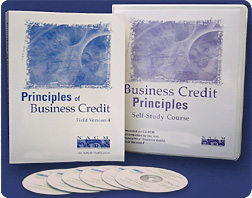
The first version of Principles of Business Credit course on CD-ROM.
... located nationwide. Each Affiliate is located within one of four geographic regions: the Eastern region comprises the eastern seaboard and New England states as far south as Virginia; the Central Region stretches from Ohio and Kentucky through the central plains states; the Southern Region spans from the Carolinas to Florida and as far west as Oklahoma and Texas; and the Western Region covers the pacific coastal states, into Utah, Colorado and Arizona.
... pertaining to exemptions for preference challenges under the Bankruptcy Code.
A powerful search engine for credit professionals located on the NACM website, the library includes the textbook, Principles of Business Credit, Credit Management: Practices and Principles, The Art & Science of Financial Risk Analysis, and the archives of Business Credit magazine.
Encompassing several very targeted work groups, each group will track and comment on very specialized areas.
... for proposed interim rules on Department of Defense contracting procedures.
... from the Chinese Government before the U.S. Congress and federal agencies pertaining to adoption of Western trade practices for China.
... on passage of Bankruptcy Bill S. 256, the Bankruptcy Abuse Prevention and Consumer Protection Act of 2005, sponsored by Senate Finance Committee Chairman Charles Grassley, R-Iowa. NACM has been advocating that the Bankruptcy code be overhauled with regards to commercial bankruptcies. Although the consumer aspects of the bill have received most of the media attention, important measures vital to commercial creditors were at stake. Three of the most important issues to NACM members contained in S. 256 are: 1. The creation of an expedited procedure for small businesses in Chapter 11; 2. Revisions in the treatment of preference challenges to creditors, and; 3. Reclamation reform.
NACM Board approved the establishment of a Scholarship Foundation, an entity that would furnish assistance to business credit professionals as they pursued credit education.
Finally a reality, the Federal Deposit Insurance Reform Act of 2005 was adopted by Congress as part of the Deficit Reduction Act of 2005 and signed by the President. This was a landmark piece of banking legislation and the final bill included merging the two deposit insurance funds, increasing coverage for retirement accounts to $250,000; indexing the insurance level for inflation; and more provisions.
... to take into consideration the importance of the free exchange of data for the purposes of extending commercial credit. The Senate had at least three versions of data security legislation introduced and debated. These bills would increase federal penalties for identity theft and require data brokers to notify consumers when the security of their personal information has been breached. NACM was working hard to ensure that the impact of these measures are clearly limited to consumer breaches and do not extend to commercial related information.
... from 600 at the end of 1896 to 22,000 in 2006 making NACM one of the oldest and largest business credit organizations in the United States.
NACM went on record to oppose the 3% withholding tax on many government contracts for goods and services scheduled to take effect January 1, 2011. NACM's efforts were recognized by Rep. Kendrick Meek (D-FL). Meek along with Wally Herger (R-CA), sponsored H.R. 1023, the Withholding Tax Relief Act of 2007, which if enacted would repeal this withholding tax.
... were revised and updated by an NACM Work Group and adopted by the NACM board.
... identified a need for an online job board to help companies identify qualified candidates for credit positions, a Lien and Bond Service to support the many building and construction focused members.
The Senate's Personal Data Privacy and Security Act of 2007 and the House's Data Accountability and Trust Act both focus on protecting consumers' personally identifiable information: how data is stored and procedures in the event of a security breach. NACM's position is that enacting measures to secure consumer data should be done in a way that doesn't inhibit the free flow of business credit information.
(now Mechanics Lien and Bond Service, MLBS) a division of NACM was formed in 2007 and debuted its first product, the Lien Navigator; a web-based guide that contains each state's lien and bond laws, as well as the suit time frames.
The original homepages of MLBS and the Lien Navigator (click to enlarge).
... at NACM's headquarters. The seminar focus was "Building the Optimal Construction Credit Department".
NACM members attended a Legal Symposium held in conjunction with the 86th New York Meeting of the Commercial Law League of America's (CLLA) Eastern Region Members' Association. This collaborative educational effort was an opportunity for NACM and CLLA members to network and forge new business.
100th anniversary of NACM’s Manual of Credit & Commercial Laws, the essential business and legal information resource for credit professionals.
The 2008 Credit Professional's Salary Survey was launched. The survey was posted online and tabulated by the Cascade Employers Association.
The NACM Board approved the funding for an Online Credit Learning Center. Users will be able to choose from 20 or so different webinar type offerings. This center will offer credit education to those new to the field.
The Great Recession was a period of marked general decline that was observed in national economies globally. The scale and timing of the recession varied from country to country. At the time, the International Monetary Fund (IMF) concluded that it was the most severe economic and financial meltdown since the Great Depression.
Lehman Brothers' bankruptcy is one of the largest failures of an investment bank. Immediately after the bankruptcy filing, an already distressed financial market began a period of extreme volatility. What followed was what many have called the "perfect storm" of economic distress factors and eventually a $700bn bailout package (Troubled Asset Relief Program). The economic crisis accelerated dramatically in the U.S. because of excessive risk-taking by banks, combined with the bursting of the United States housing bubble. This burst reverberated throughout the world (click to enlarge).
The FTC delayed the enforcement of the Red Flags Regulations and Guidelines, which require most creditors and financial institutions to adopt a written program to detect, prevent and mitigate identity theft in connection with a new opening of a covered account or any existing covered account. Because the definition of a covered account is so broad NACM recommends that all credit departments take the lead in conducting its company's risk assessment and then assisting with the design of a written program to comply with the FTC's Red Flags Regulations. NACM has been actively attempting to clarify the FTC's Red Flags Regulations language and its effect on trade creditors and was instrumental in the delay of the enforcement of regulations.
... (which greatly accelerated and increased the impact of the Great Recession) has affected every industry leaving credit departments to do more with less, a common theme across the country. This credit crisis started by sub-prime mortgages led to an international disaster in the financial world.
2010s
The Rise of Social Media....
Known as the “Father of Credentialing,” O.D. Glause was NACM president in 1971-1972 and a prime advocate of credit education. He was the guiding force for the formation of NACM’s first certification program. The first designation awarded under the program was the Accredited Business Credit Executive (ABCE), which later became the Certified Credit Executive (CCE). In 2011, NACM’s Credit Executive of the Year award would be renamed the O.D. Glaus Credit Executive of Distinction.
The Father of Credentialing (click to Open/Close)
Known as the "father of credentialing" to many, O.D. Glaus Jr., CCE passed away on February 2010. His contribution to the credit profession and to NACM is legendary. "O.D. was the type of person that, the first time you met him, he left an impression," said current NACM National Chairman Phyllis Truitt, CCE, director of credit at Atlas Van Lines, Inc. "He added value to people's lives. He was there to assist you in any way he could and he would always make time, no matter how busy he was."
"He was just such a grand person and he will be missed," she added.
A native of Nashville, Glaus received his bachelor's and master's degrees from Vanderbilt University, where he was active in fundraising activities, alumni affairs and a trustee for the Phi Kappa Psi Fraternity. Glaus was also always active in community and business activities, holding many positions at the Belmont United Methodist Church and becoming a member of both the Masonic Lodge, including the Knights Templar, Shrine and Potentate Guard, as well as the Elk's Lodge.
Glaus, NACM Chairman from 1971-1972, was a true Southern gentleman who is still held in the highest esteem by his colleagues in the Association and in the business commuinity. His wife range of expertise and proven expert judgement, along with the qualities of thoughtful deliberation and thoroughness, provided NACM members with dynamic leadership for many, many years.
A veteran with four years of service in the European and Pacific Theaters during World War II, he started his business career as a university instructor, then went to Genesco in Nashville, where he worked as general credit manager for virtually his entire career of 48 years, 46 of which were spent as an NACM member. Throughout his time in NACM, he was an active member both on the local and national levels. He contributed outstanding service to the Association, holding just about every office in the association, and was involved in nearly every major development in the profession in the last 35 years.
"In everyone's life there is a mentor—a teacher, counselor and friend. O.D. was all of that to me. We called him 'professor,' but ironically, it was his quest for constant learning that made him such a student of the art of business credit," said Terry Callahan, CCE, president of the Credit Research Foundation (CRF). "I owe the success I've had in my career to him for all that he taught me and the example he set for me when I started business credit 35 years ago, and he will always be remembered by the thousands of lives he touched."
Throughout his career, Glaus was a prime advocate of credit education. For 20 years, he taught local college classes on the principles of credit, and nationally he was a guiding force in the establishment of NACM's professional accreditation program. Founded in 1972, accreditation was originally awarded under the title of Accredited Business Credit Executive (ABCE), a title that grew into the modern Certified Credit Executive (CCE). "He was a visionary," said NACM President & COO Robin Schauseil, CAE. "He was such a believer in education and professional development, and truly saw how beneficial these things were to individuals and to the business credit profession at large."
The original objectives of accreditation program remain today: to 1) raise professional standards and improve the practice of business credit management; 2) identify and give special recognition to individual credit executives with specified levels of experience; 3) enhance the function of business credit management as an important contributor to company profits and the business credit executive as a key member of company management; and 4) assist the entire business community in establishing an objective measure of an individual's knowledge and experience in the field of business credit maangement.
When honored as the 1990 National Credit Executive of the Year representing the Southern region, Mr. Glaus said, "If I were going to leave a legacy to the profession, it would be learning is a neverending process—nobody lives in a cocoon—and communicating with people, learning together and aspiring for excellence are the most important things. We never stop learning. You have to stay alert and in-tune to what's going on, not to what happened in the past. You need to find a way to make things happen, work out solutions, and have the opportunity to work with people."
"O.D. was mostly noted in the credit business as te person who hired and mentored a lot f credit professionals, trained them and moved them on to other companies to be directors of credit," said Connie Cheak, CBF, president & COO of NACM South Central. "That was his greatest contribution to the credit profession. Everybody respected him and when he spoke everyone listened. We considered him Mr. NACM."
Originally published in the April 2010 issue of Business Credit.
NACM continued its bankruptcy reform effort by meeting with both majority and minority Senate Judiciary staff, specifically offering support to Sen. Sheldon Whitehouse (D-RI) for drawing attention to the Bankruptcy Code and introducing a bill to improve its functioning.
CLICK
NACM submits a letter to Sen. Sheldon Whitehouse (D-RI) and other members of the Senate Judiciary Committee voicing concerns about a proposal that would expand Chapter 12 of the Bankruptcy Code to apply to small businesses in addition to fishermen and family farmers.
CLICK
After the Federal Trade Commission (FTC) delays enforcement of its "Red Flags" Rules, NACM sends a letter to the FTC urging the agency in the future to create regulations that aren't needlessly broad and clarify the differences between consumer credit information and commercial credit information.
CLICK
In December, NACM begins work on guidance for commercial trade creditors following the enactment of the "Red Flags" Clarification Act.
CLICK
NACM finalizes its guidance for trade creditors to comply with the Federal Trade Commission's (FTC's) newly-amended "Red Flags" Rules.
CLICK
Michael Puccinelli, CCE becomes the first recipient of the O.D. Glaus Credit Executive of the Year award. Formerly named the National Credit Executive of the Year, the award honors the memory of the “Father of Credentialing” O.D. Glaus, Jr., who was NACM president in 1971-1972.
CLICK
NACM continues work on Bankruptcy Code reform, urging Sen. Sheldon Whitehouse (D-RI), after a series of meetings, to include NACM's Section 547 reform language in any new bankruptcy legislation.
CLICK
NACM formally endorses a new bill originating in the House Judiciary Committee that would reform the Bankruptcy Code's venue provisions and aim to put an end to forum shopping.
CLICK
After one final grassroots push, NACM completes its campaign against the 3% withholding tax on most government contracts as the measure is repealed.
CLICK
NACM begins the year by exchanging proposals to reform Section 547 of the Bankruptcy Code with the Commercial Finance Association (CFA) and the Commercial Law League of America (CLLA).
CLICK
NACM submits a comment to the Consumer Financial Protection Bureau (CFPB), created a year prior as a result of the Dodd-Frank Wall Street Reform and Consumer Protection Act, pertaining to its regulation of debt collection and credit reporting services.
CLICK
NACM rebrands the Mechanics’ Lien & Bond Services (MLBS) to Secured Transaction Services (STS) in conjunction with adding UCC Filing Services to its line-up of products and services that include the Lien Navigator, Preliminary NTOs and the Lien Waiver Manager.
CLICK
NACM mobilizes its membership in Tennessee to contact Congressman Steve Cohen (D), ranking member of the House Judiciary Subcommittee on Commercial and Administrative Law, to support NACM’s proposed language to reform Section 547 of the Bankruptcy Code, which would shift the burden of proof in a preference claim from the creditor to the debtor.
CLICK
NACM begins a campaign in articles and educational programs to inform trade creditors about how the preliminary approval of an antitrust settlement that allows merchants to pass on their credit card processing fees to their customers applies to their business.
CLICK
Ten years
CLICK
HB 2198, a bill that would, among other provisions, require commercial credit reporting providers to disclose to the subject of a commercial credit report the source of any so-called “negative information,” is introduced in the Virginia House of Delegates. NACM voices its concerns about the negative ramifications such a bill would have on the free and open exchange of credit information.
CLICK
NACM formally announces its opposition to HB 2198 in Virginia, citing the cooling effect it could have on the exchange of commercial credit information on businesses in the Commonwealth.
CLICK
Following an update of the Credit Business Fellow (CBF) designation, NACM unveils a new addition to its vaunted Certification Program, the Certified Credit and Risk Analyst (CCRA) designation.
CLICK
FCIB signs a Memorandum of Understanding (MOU) with the U.S. Commercial Service of the U.S. Department of Commerce’s International Trade Administration (ITA) to increase awareness among U.S. businesses about exporting tools and resources available to them. In the same month, ITA unveils the first Spanish-language edition of the Trade Finance Guide: A Quick Reference for U.S. Exporters, created in partnership with FCIB.
CLICK
NACM members testify before the ABI Commission to Study the Reform of Chapter 11 at the 117th annual Credit Congress, hosted in Las Vegas.
CLICK
NACM responds to an Associated Press article about small business commercial credit reporting that fails to even mention the involvement of commercial trade creditors and vendors in the creation of a small business’ credit profile.
CLICK
NACM releases a free fact sheet, titled “Commercial Credit Reporting: What Every Company Needs to Know,” in support of National Small Business Week 2013.
CLICK
NACM appears in a Wall Street Journal article focusing on commercial credit and allegations of aggressive sales tactics by Dun & Bradstreet Credibility Corp. (DBCC).
CLICK
NACM members, affiliate staff and national staff testify about the dangers of HB 2198.
CLICK
NACM, in partnership with FCIB, announces the launch of the Graduate School of Credit & Financial Management International (GSCFMI) to continue its dedication to the global promotion and enhancement of the business credit professional. Participants also have the unique chance to network with students in the GSCFM program running concurrently with the GSCFMI.
CLICK
NACM announces the hiring of Rudet Fountain to the position of executive vice president and tasked with strengthening the sales of NACM’s business services and developing a cross-functional sales team at NACM. Rudet is already well known in NACM circles, having served as vice president of NACM relations for United TranzActions for 15 years.
CLICK


